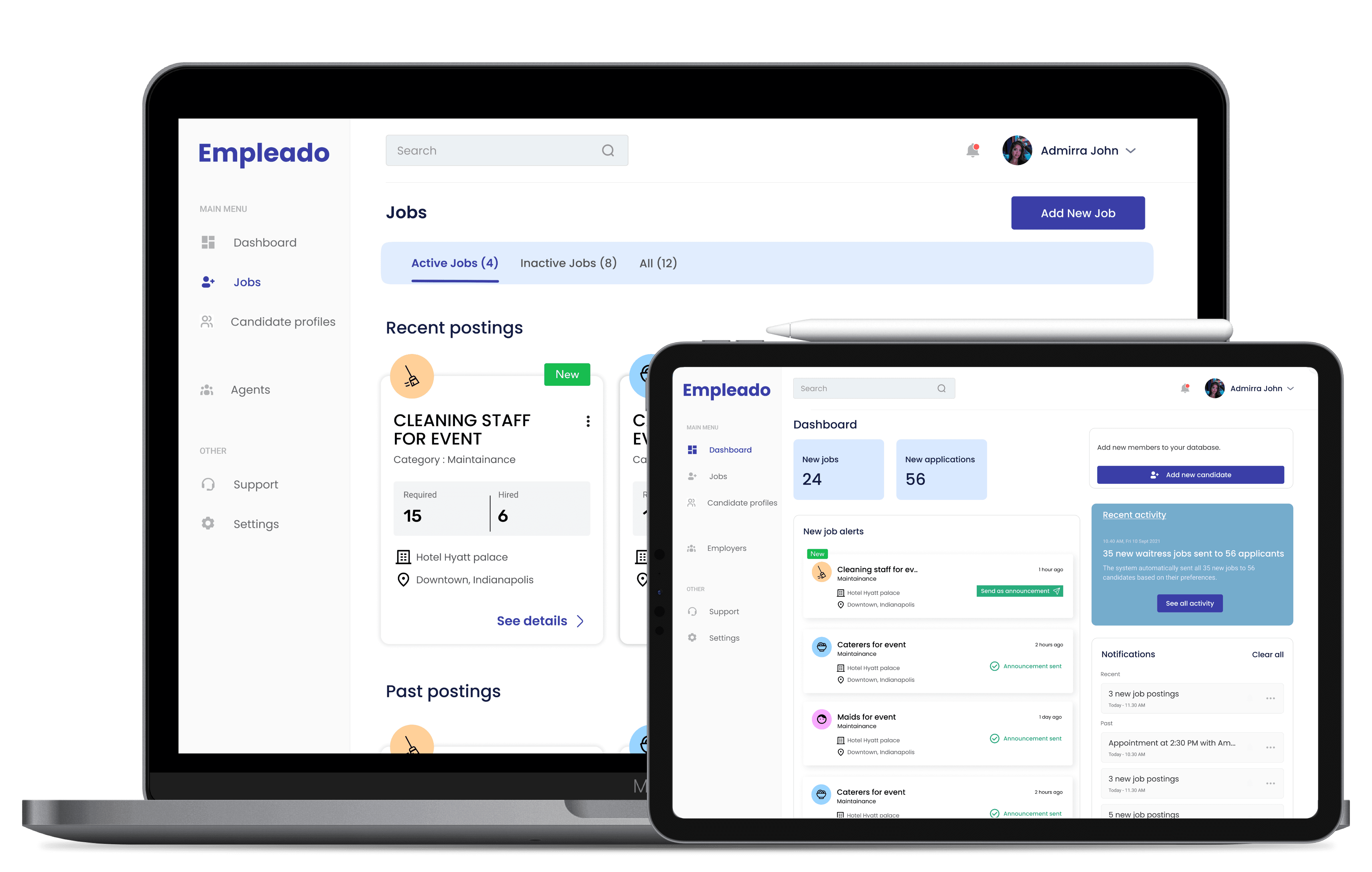Who would benefit?
Based on the literature survey, interviews, observations, and competitive analysis, we found that existing job search platforms do not effectively serve low-literate job seekers.
Consequently, two personas were developed - one for the business owner and the other for the job applicant.
Problem statement -
"How can we create a platform that minimizes the use of technology for low-literate job seekers and helps them find and apply for jobs?"
We decided to only use the affinity diagramming technique for two reasons.
Time constraint
It helped focus on the pressing needs of low-literacy job seekers by organizing the complex and multifaceted limitations they face.
Benefit to our personas
Scenario 1
Johannes, a recent widow and mother of two kids who is passionate about textile weaving, finds a job through the app with Blaire, a small textile business owner who is seeking weavers at a budget-friendly price.

Johannes lost her corporate job due to the recession and wants to pursue her passion in textile weaving, but doesn't know where to find related jobs.

As a new textile business owner, Blaire cannot afford high labor costs and struggles to find weavers who are willing to work for his offered price.

Johannes uses our application to find various job opportunities while Blaire uses it to post vacancies for his textile business.

Johannes and Blaire find each other through the app and Johannes is successfully hired by Blaire.
However, this approach posed a challenge because it still relied on technology-driven job search processes, which the low-literate population struggles with.
Scenario 2
Josh, a builder in need of construction workers, and Jeffery, a contractor with a surplus of workers without ongoing work, use the app to connect and complete a successful contract together.

Josh is a builder but finds himself shortage of construction workers as they have migrated back to their home country due to covid.

Jeffery is a contractor who manages construction workers for various projects and is left with few of them without any ongoing work.

Both of them discover our application to be able to satisfy each others requirement.

Josh works with labor provided by Jeffery and completes his contract successfully.
To fully address the issue of limited job opportunities for low-literacy individuals, a comprehensive approach is needed that serves the needs of all job seekers, not just those who are connected with an agent.
Solution
Business owner posting a job vacancy.
Agent adding new candidate to the database.
Job applicant contacting the agent.

Applicant contacts agent and provides their interests and experience for agent to add to the database.

Agent provides the applicant with a list of open job vacancies based on their preferences and provides further assistance.

Agent sends job description and details of particular jobs to the applicant based on their interests.
Testing and evaluation
Usability testing was conducted with 4 potential users and 4 experts to assess the feasibility and key usability issues of the proposed tool using the think-aloud protocol and recorded our observations.
Tasks provided
Add a new job posting as a business owner.
Add new candidate’s information on the agent’s database.
What worked

We found that all participants were able to successfully complete these tasks, indicating that the platform's design was intuitive and user-friendly.
Participants were able to easily post new job vacancies as a business owner.
Participants were able to add new candidates to the database without any difficulties.
What did not work

1.
"..the dashboard's real-time data is overwhelming due to its crowded display."
"..confusing sections on the dashboard."
Business module



Agent module


2.
"..how will employers, agents, and applicants connect with one another?"
"..the communication between employer and agent is unclear."
Modifications to the platform's sidebar menu now enhance communication between agents and business owners, establishing a clearer interaction channel.
The term "members" was replaced with "candidate profiles" for greater specificity and to reduce user confusion.
3.
"..applying for each candidates for specific jobs seems cumbersome."

We discovered that agents were unable to select multiple candidates before applying for a specific job, which was an important feature we had overlooked.
This feature was incorporated into the design to streamline the application process and enable agents to apply to a specific job with multiple candidates
Project outcomes
Outcome #1
Challenge
Team disagreements on project direction, causing delays and confusion.
Resolution
Aligned project direction by providing constructive feedback, including financial details for employers and labor laws for applicants.
Learning
Effective communication is key to project success, ensuring all team members understand project goals to avoid misunderstandings and delays.
Outcome #2
Challenge
Limited time impacting project scope and deliverables.
Resolution
Skipped empathy mapping due to a missed deadline, focused solely on affinity mapping to maintain progress while utilizing user research insights.
Learning
Being adaptable is crucial. It's important to remain flexible and adjust to unexpected challenges to meet project goals.
Outcome #3
Challenge
Team members lacked experience in user research and interviews.
Resolution
Leveraged individual strengths: one with programming background handled systems, another experienced in UI design developed screens, while I recruited participants and led interviews, with two others taking notes.
Learning
Emphasized the importance of collaboration and delegation to use team strengths effectively and support one another in achieving project goals.
Next steps
Include an onboarding process to provide clarity about the purpose and use of the application.
Use consistent spacing, icon style, and dimensions, and a limited number of colors to improve the overall aesthetic and usability of the app.
Include a feedback system to enable users to highlight any grievances or issues.
Conduct a UX audit to identify and address any additional issues with the design and functionality of the app.
Pain points to design opportunities
Competitors in the market
We discovered that there are three commonly used types of solutions for connecting business owners with a low-literate workforce, which we considered in the development of our platform.
The current job search platforms like LinkedIn, Indeed, and Craigslist are not suitable for low-literate job seekers.
These platforms often have a complicated user interface with advanced features that are difficult for low-literate users to navigate.
They also lack personalized support and resources for low-literate users, which can make it challenging for them to find and apply for suitable jobs.
Project background
Problem
Solution
We designed a platform that facilitates the connection between business owners seeking a workforce and agents who are willing to assist low-literacy job seekers in finding and applying for suitable vacancies. The main aim is to minimize the use of technology for these job applicants.
Targeted users
My role
Field research and narrowing down the problem, ideation, storyboarding, and agent module app design.
What was the necessity?
"According to the International Labor Organization (ILO), as of 2017, 5.6% of the global population was unemployed."
"...people without any digital skills have low employability and will remain inactive and while not employed, deprived of income, their chances to acquire necessary digital skills will remain low."
Who we spoke to
Here is what people have to say



Empleado
Developing a digital platform to help low-literacy job seekers find and apply for jobs with volunteer agents.
This project was undertaken to contribute to addressing UN Sustainable Development Goal 8: promoting inclusive and sustainable economic growth, employment, and decent work for all.
Proposed concept
“How can we simplify the job search process for low-literate job seekers?”
All test participants successfully engaged with the platform, highlighting its usability and effectiveness.
Overview
←























